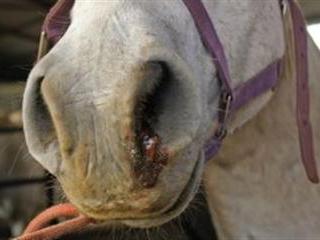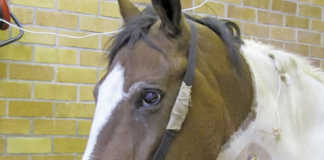
The guttural pouch is a pair of air chambers in the horse’s neck, just behind the skull and below the ears. They’re thought to control the air flow around each auditory tube and cool blood flow to the brain during exercise. But whatever their purpose, if something goes wrong with the guttural pouches, the consequences can be terrible.
If your horse’s nose bleeds, it’s a sign the pouches may be infected. And you need to contact your vet, because the sooner you react, the less suffering your horse will experience and the better the prognosis.
Three Kinds
Three kinds of disease can affect the pouch: guttural pouch tympany, empyema and mycosis. Guttural pouch tympany: Affects mainly fillies. Air moves into the guttural pouch through the auditory canal, but can’t leave via the pharynx. This causes the pouch to swell up like a balloon. If you tap the guttural pouch it will sound like a drum.
Treatment: General surgery after an accurate diagnosis is made with an endoscope. This allows air to flow out the guttural pouch and into the pharynx. Guttural pouch empyema: Occurs when bacteria enter the guttural pouch through the pharynx. Usually the pouch can easily deal with this, but if it can’t, pus will build up and the pouch will swell. It will eventually become so enlarged that thick white or yellow pus will come out of one or both of the nostrils, and the horse will have difficulty breathing.
Treatment: After an accurate diagnosis is made with an endoscope, an incision is usually made at the side of the pouch to allow the pus to drain out. Then the pouch is aggressively flushed. Antibiotics, and sometimes painkillers and anti-inflammatories, are given to reduce inflammation. Guttural pouch mycosis: The most severe of the three, and caused by fungal infection. This embeds itself in the wall of the guttural pouch over an artery.
The infected artery then starts to bleed. This is obviously very dangerous, as your horse can bleed to death. If left untreated the fungal infection may also damage nerves in the area causing a permanent inability to swallow. The trickle or gushing of blood out of one or both nostrils at rest allows you to rule out exercise-induced pulmonary disease.
Treatment: The fungal infection is best removed surgically. The affected artery is bypassed by preventing the flow of blood to it, and anti-fungal drugs are used after surgery.
Contact Kim Dyson on 082 888 6511 or at [email protected]. Please state ‘Horse therapy’ in the subject line of your email.













